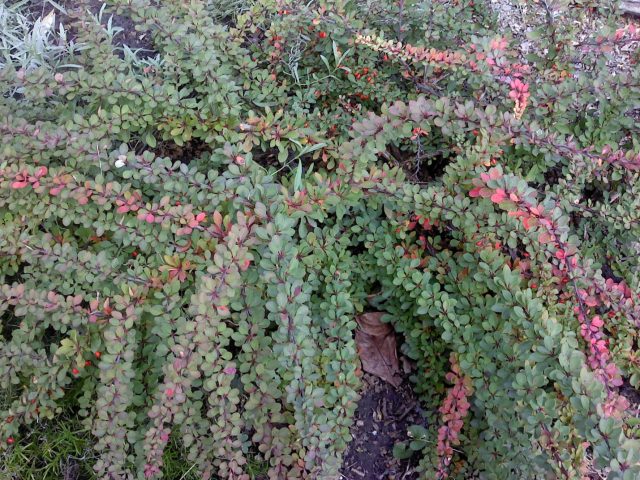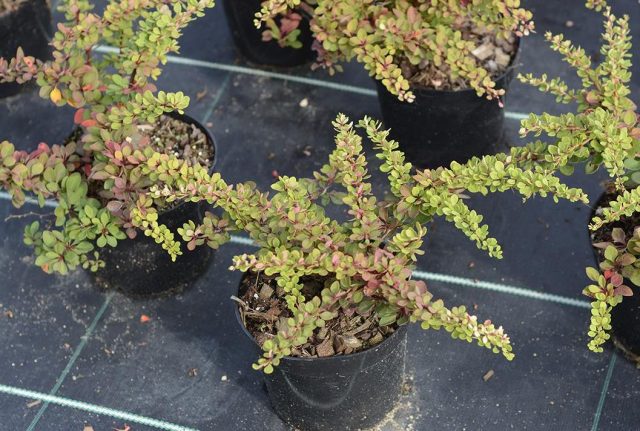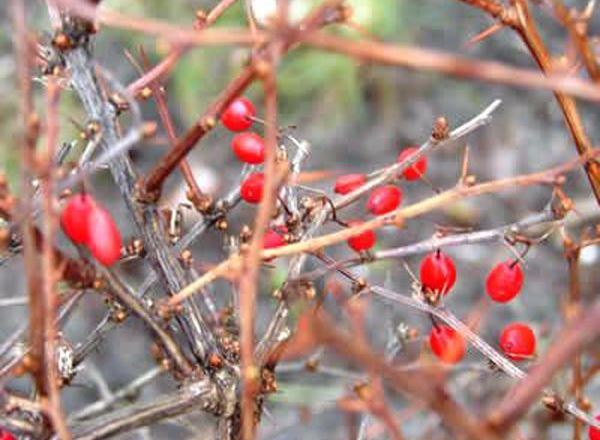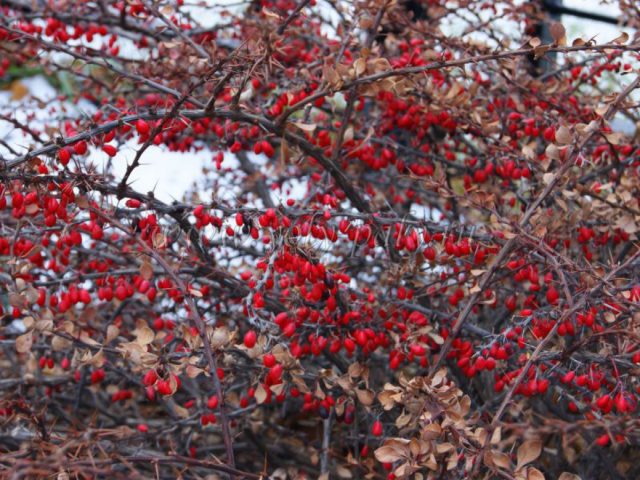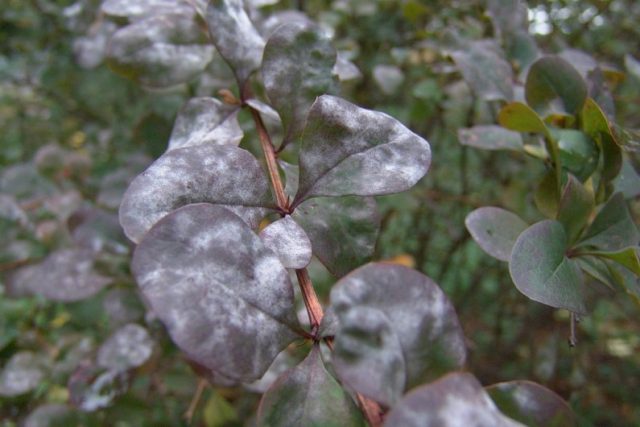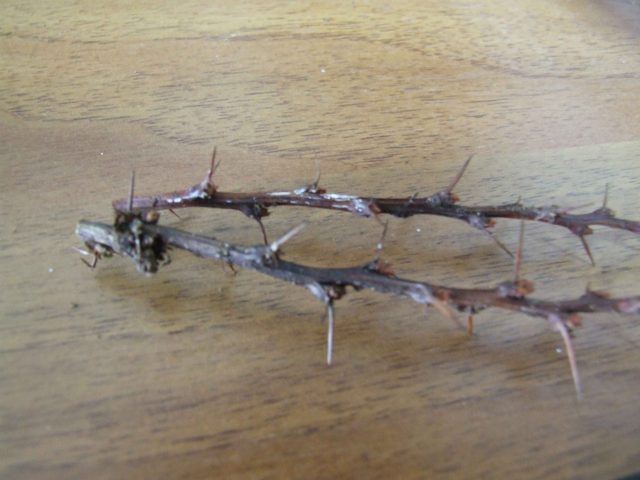Content
Barberry Green Carpet is a small fluffy shrub often used for landscaping sites. This plant is distinguished by its endurance and unpretentiousness, while having a bright attractive appearance.
Description of barberry Green Carpet
Barberry Thunberg Green Carpet belongs to deciduous shrubs. It is distinguished by its compact size and low spreading crown. The diameter of an adult plant usually does not exceed 100 cm. The shape of the crown is wide and slightly flattened (it is often compared to a pillow). The color of the bark is yellowish brown.
Barberry Green Carpet begins to bloom in late spring. The inflorescences are several single flowers gathered together. The color of the flowers is red on the outside, and deep yellow inside. The fruits are elongated and have a pink or red hue. The ripening period of the fruits of the Green Carpet barberry is the beginning of autumn. After the leaves from the bush fly around, the berries remain on the branches for a long time, decorating the garden in the winter months.
Also, to the description of the Thunberg barberry Green Carpet, it should be added that it is a perennial plant, the shrub can grow on the site for 45-50 years.
Planting and leaving
Barberry is a rather unpretentious shrub - habitat conditions are completely unimportant for most species. The plant adapts well to environmental conditions and is able to grow and develop anywhere. If it is possible to choose a planting site for the Green Carpet barberry, you should give preference to areas open to sunlight, but protected from sudden gusts of wind.
Seedling and planting plot preparation
Novice amateur gardeners are usually advised to buy ready-made saplings of Green Carpet barberry. If we are talking about a plant with open roots, it is recommended to dip the roots of the seedlings in liquid fertilizer for a couple of hours before planting. If the seedling grows in a pot, then 15-20 minutes before planting it is watered abundantly with water so as not to damage the roots during extraction.
In terms of land, neutral soil works well for Green Carpet barberry. But at the same time, he can adapt well to an alkaline or acidic environment. To improve the quality of acidic soil, it is recommended to pre-fertilize it with lime or wood ash.
It is better to prepare holes for barberry Green Carpet in advance - 5-10 days before disembarkation.
Landing rules
Experienced gardeners advise you to follow simple rules when planting the Green Carpet barberry variety, which will help the plant quickly adapt to a new place:
- individual seedlings should be located at a distance of 2 m from each other, and when creating a continuous hedge - 50 cm;
- barberry no more than 3 years old is planted in holes 25 by 25 cm in size, older specimens - in holes 40 by 40 cm;
- disembarkation is carried out in April in order to be in time before bud break;
- if the soil at the landing site has a heavy, dense structure, it is worthwhile to prepare in advance a special soil mixture - superphosphate or sand with soil and humus;
- before planting barberry in the holes, it is necessary to prepare drainage from sand or broken brick;
- saplings of barberry of the Green Carpet variety are placed in the holes, carefully spreading the roots, and sprinkled on top with soil or ready-made soil mixture, and then watered (a bucket of water per plant).
Watering and feeding
As for leaving, the Green Carpet barberry variety is quite unpretentious and undemanding in this regard. The plant does not require abundant watering and does not tolerate waterlogging.
In the first year after planting the Green Carpet barberry bush, you can do without the introduction of additional fertilizers - the nutrition from the soil mixture should be enough for this period. In the future, for fruiting, after flowering, you need to feed the Green Carpet with potassium-phosphorus fertilizers and reapply them at the end of the season.
Pruning
An important stage in the care of Green Carpet barberry bushes is their timely pruning. The first year the plant is allowed to adapt, and, starting from the next, pruning is carried out twice. The first is done at the beginning of summer, and the second at the end. The branches of the plant are pruned by about 50%. You should also not forget about sanitary measures - timely remove dried or too thin shoots.
Pruning barberry Green Carpet is carried out using a pruner or a garden hacksaw. Do not forget about protective gloves, as thorns can be hidden under the foliage of the barberry. First, excess shoots are removed from the ground, and then the formation of the crown is carried out.
Preparing for winter
The most important thing for the Green Carpet barberry in winter is to protect the roots from frost. To protect the plant, hilling is carried out in the fall to a height of 10-12 cm.
In general, the Green Carpet variety tolerates winter well. If a lot of snow is predicted, then the bushes can be left uncovered. If there is a high probability of a cold, snowless winter, then you should take care and cover the barberry with spruce branches.
Reproduction
There are several ways to breed the Green Carpet barberry. They are all pretty simple and easy to use. To choose the right one, you should familiarize yourself with them in more detail:
- With the help of seeds. Ripe berries are harvested, seeds are taken out of them, disinfected in a solution of potassium permanganate of low concentration and dried. The prepared seeds are planted to a depth of 10 mm on a temporary bed, and in April the sprouts dive, leaving a distance of 3-4 cm between them. When the seedlings reach 2 years, they are transplanted to a permanent place. It is also possible to plant seeds in spring, in which case they must be kept in wet sand or coconut substrate for 2-3 months at a temperature of + 2-5 ° C.
- With the help of cuttings. Breeding preparation begins in early summer. The foliage is removed from the cuttings, leaving only a little at the very top. After that, the cuttings are placed in a container with a root solution for several hours in order to stimulate the development of the root system. The prepared material is planted on a temporary bed. During the first weeks, it is very important to ensure that the soil is sufficiently moist. After 2 years, young bushes can be transplanted to a permanent place.
- With the help of layering. At the beginning of spring, the strongest shoot is chosen and placed in a specially prepared groove no more than 10 cm deep, fixing it in this position. In this case, the end of the shoot should be above ground level. The place where the roots will form can be scratched a little to speed up the process. In the fall, the resulting seedling is transplanted to the planned location.
- By dividing the bush. This method works well for low-growing varieties such as the Green Carpet. Bushes aged 3-6 years are suitable for reproduction. In April, the bushes are completely removed from the ground and, trying not to damage the root system, they are carefully divided into parts using a garden hacksaw. Slices are recommended to be treated with a weak solution of potassium permanganate or charcoal. Parts of the bush are planted in a new place.
Diseases and pests
This variety of barberry is famous for its fairly strong immunity and resistance to many diseases found in ornamental shrubs. However, there are also diseases and pests that can harm the plant.
An important measure for the prevention and care of the Green Carpet barberry variety is the treatment of aphids and moths. Aphids settle on the lower part of the leaves of the plant and multiply very quickly. As a result, the leaves begin to dry and fall off, and the shoots bend. Under such conditions, next year, new buds on the plant may not appear.In stores, you can buy special spray preparations that prevent the appearance of the pest.
The moth is eating the berries of the barberry. In the fight against it, fufanon or decis preparations are very effective.
Among diseases, powdery mildew, which is caused by a type of fungus, is a great danger. It appears as a whitish bloom on shoots and leaves in early summer. If you do not pay attention to this sign, then the fungus will mature during the season and, having overwintered, will spread even further by spring. As a result, this will lead to the death of the bush. The timely use of special fungicides, which can be purchased at garden stores, will help to rid the plant of the disease.
Another nuisance that can happen with barberry is leaf spot. The fungus infects the leaves, on which dark spots begin to appear, over time, the shoots die. To avoid the disease, it is necessary to spray the bushes with copper oxychloride in the spring and after the end of flowering.
Bacteriosis caused by pseudomanas is common. Otherwise, this disease is also called bacterial cancer. In the photo of the Green Carpet barberry, you can see that bacteriosis is manifested by cracks on the shoots.
If such signs appear, the damaged branches should be removed immediately to prevent further spread of the disease. Spraying with solutions in this case will not give the desired effect.
Conclusion
Barberry Green Carpet is perfect for decorating a summer cottage or personal plot. Growing and caring for it will not cause much difficulty even for novice gardeners.

